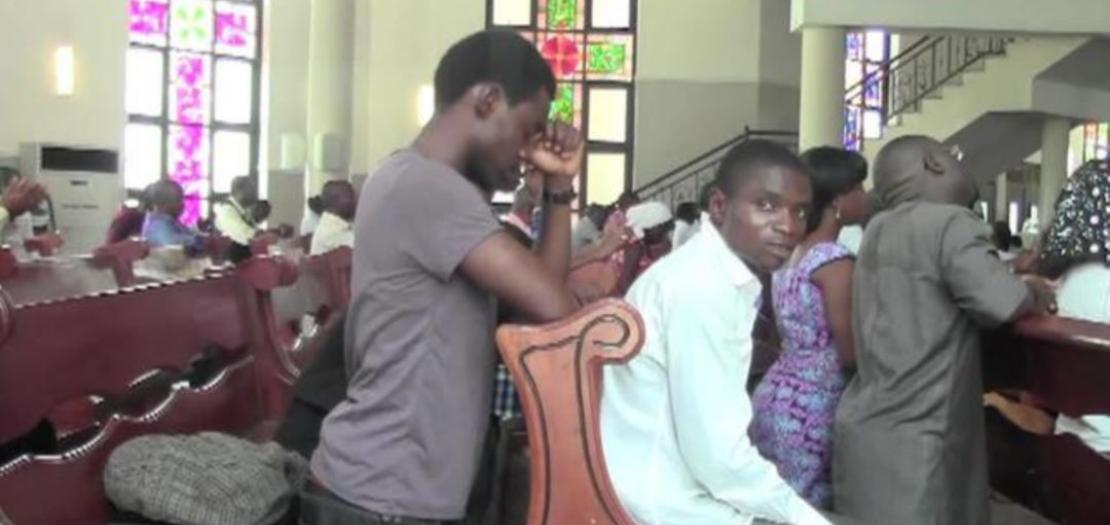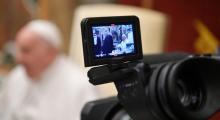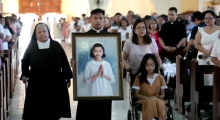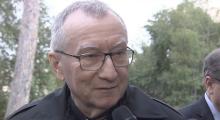Issued by the Catholic Center for Studies and Media - Jordan. Editor-in-chief Fr. Rif'at Bader - موقع أبونا abouna.org

The Church is enjoying robust growth in Africa yet faces several challenges. “African Catholicism remains on the margins of global theological thinking,” an expert told "La Croix".
How big is the Catholic Church in Africa?
Vatican data revealed in 2015 that there were a little more than 222 million Catholics in the continent – one in every five inhabitants – representing 17 percent of all the word’s Catholics.
That’s two percent more than in 2010.
Most of them live south of the Sahara – the north of the continent is predominantly Muslim.
Distribution is uneven: the countries with the greatest proportion of Catholics are Burundi, Equatorial Guinea, the Democratic Republic of the Congo, Angola, and the Seychelles.
The growth of the faith is also reflected in the number of priests, which, in stark contrast to the picture in Europe, has increased by 20 percent in five years.
As the number of priests in North America and Europe has shrunk by five percent over the last five years, Africa has started exporting them.
What’s behind this trend?
The growth of Catholicism in Africa is primarily due to the continent’s demographic vitality. According to projections by the NGO Population Reference Bureau, several countries in West Africa could see their population grow more than 2.5 times by 2050.
However, population growth alone does not explain the steady growth of African Catholicism, which is taking place at a greater rate.
Between 2010 and 2015, the Catholic population grew by 19 percent, against 9.6 percent for the population at large.
Another factor, according to Cédric Mayrargue, a political scientist at Les Afriques dans le Monde, an academic research institute, is that the continent still has lots of potential for conversion.
“Whole areas still practice traditional religions and are considered mission territories. This is reflected in the percentage of baptisms received after the age of seven (33 percent) almost twice as high as the world average.”
For Philippe Hugon, a researcher at the French Institute for International and Strategic Affairs, there is also a social component to the phenomenon.
“In Africa, the priest not only has a religious role but also a status, close to that of a teacher, like in Europe in the nineteenth century. Being ordained opens the door to a certain renown that attracts many young people.”
Is this growth reflected in the Vatican?
Since his election in 2013, Pope Francis has appointed six African cardinals, making them more numerous than those from Asia and North America, but still fewer than those from South America and Europe.
“There is a real paradox between the numerical growth of the Catholic church in Africa and its weak representation in the institutions,” said Mayrargue.
“African Catholicism remains on the margins of global theological thinking,” he added.
Yet the Catholic Church in Africa has a lot to offer to the broader Church, according to Bernard Ugeux, a white Father in Congo.
“Africans tend to be very religious. They can bring the spirit of celebration, of family and community prayer, to westerners, who practice such things less.”
What about other churches in Africa?
Since the 1980s, the Catholic Church has faced competition in Africa from the Pentecostal and Evangelical movements, particularly from the Anglo-Saxon world and South America.
One often hears about an “exodus” of Catholics to these Protestant churches, which boasted 15 percent of the continent’s inhabitants as members in 2015.
Mayrargue warned against overstating this point, noting that the picture varied greatly from country to country.
“It’s not a one-way street,” he said. “People come back to the Catholic faith. The borders are soft and some people have feet in both camps.”
His view is echoed by Ugeux: “Pentecostalism contains some aspects of traditional local religions. We see some believers going to mass on Sunday, and then calling on a pastor as soon as they become concerned about sorcery or healing.”
Mayrargue draws a distinction between two types of believers who may be attracted by Pentecostal and Evangelical discourse.
On the one hand, there are “vulnerable populations in search of answers to the problems of everyday life", and on the other, there are the middle and urban classes who are seduced by “a theology that values social advancement and individual fulfillment”.
How to respond to this challenge?
“The Catholic charismatic Renewal could be one answer, and this is very often combined with Pentecostal and traditional religion in Africa," explained Ugeux,
He believes the future of the African Catholic Church depends on its ability to adapt to local cultures.
This idea was also evoked by John Paul II during a sermon he gave in Malawi in 1989, when he told the congregation, “"Today I urge you look into yourselves. Look at the riches of your own traditions.”







